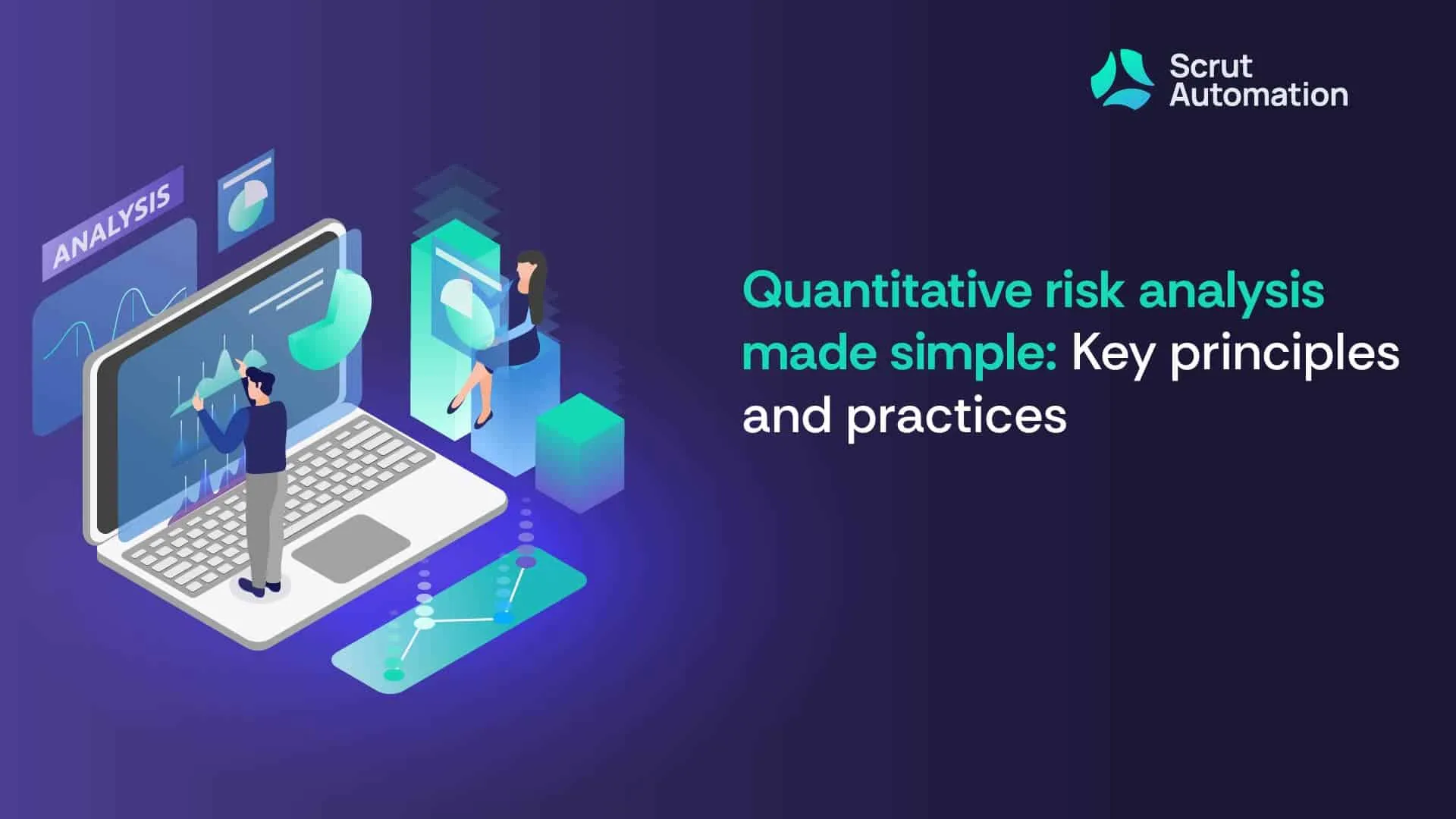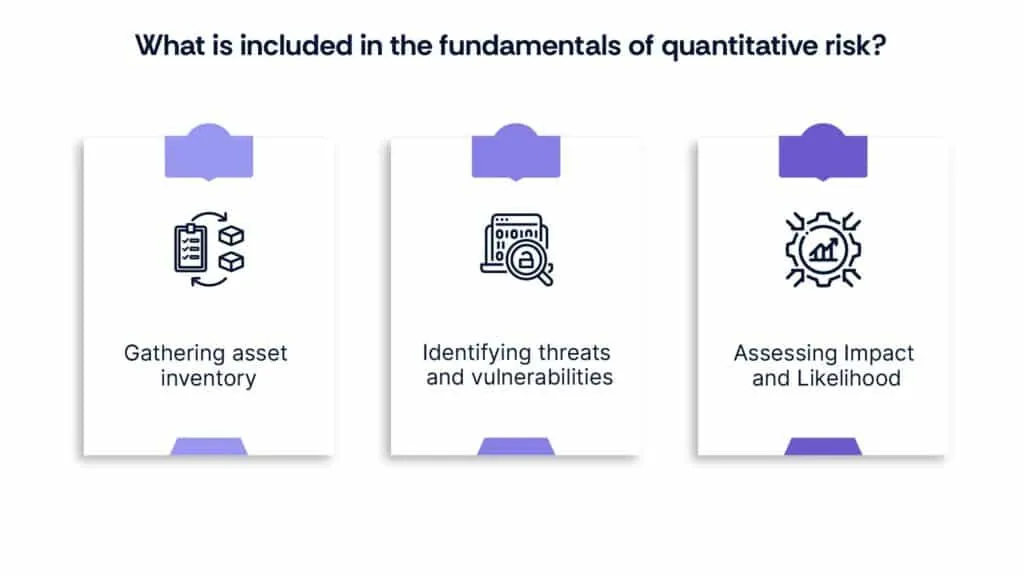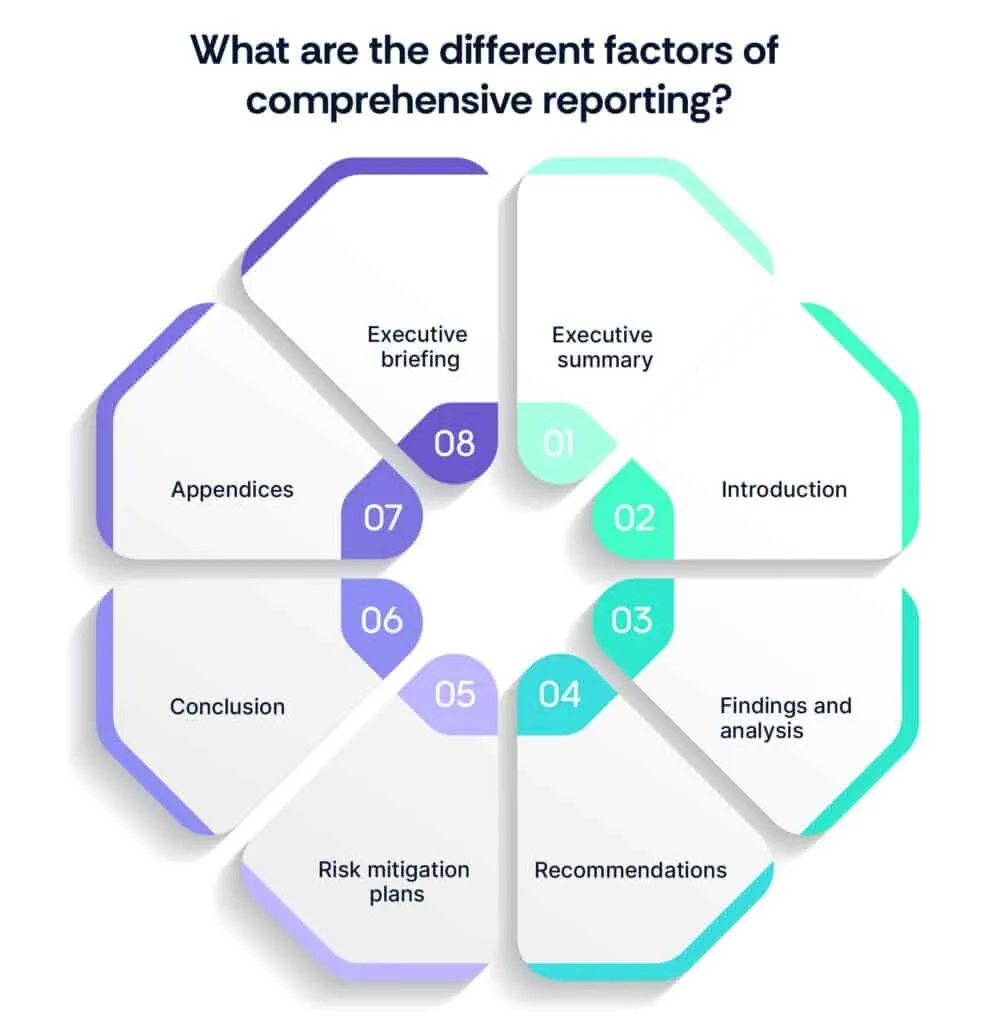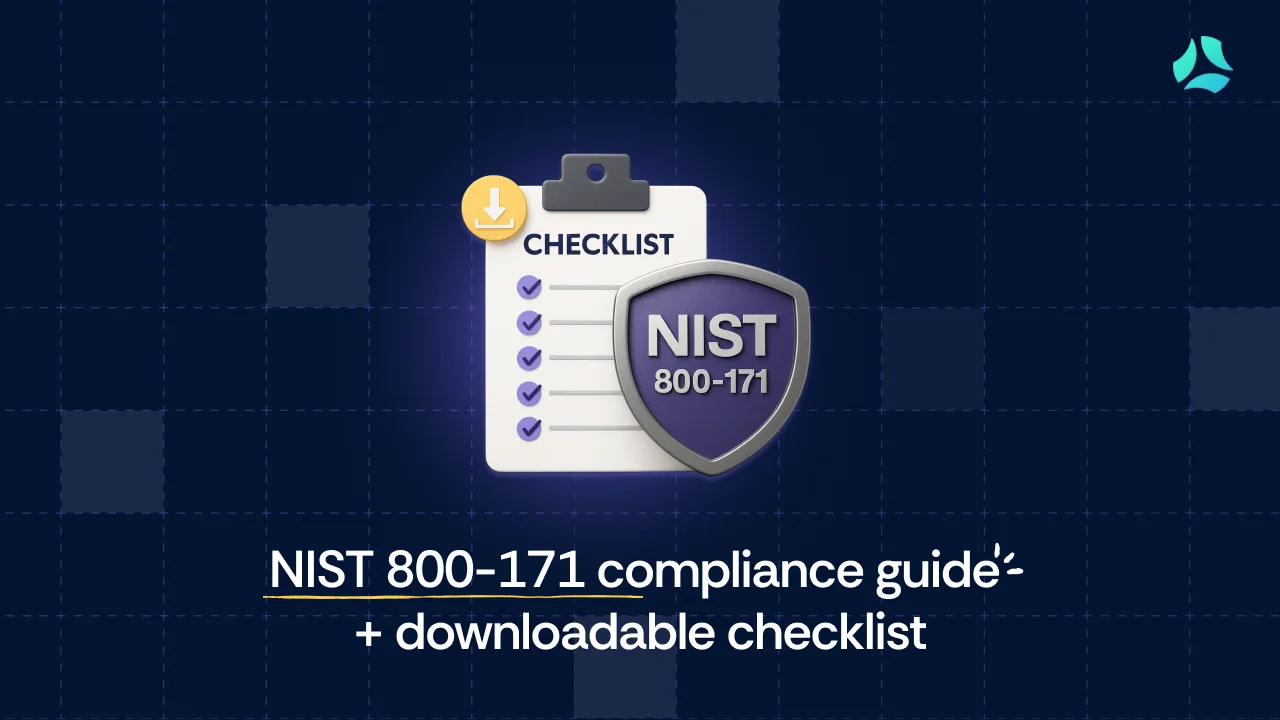Mastering Quantitative Risk Assessment and Analysis: A step-by-step guide in 2025

Quantitative Risk Assessment (QRA) is a structured method for evaluating the likelihood and consequences of hazardous events, expressing the results numerically as risk. In cybersecurity and compliance, quantitative risk analysis plays a crucial role in assessing the risk exposure to employees, the environment, company assets, and reputation. By utilizing measurable, objective data, quantitative risk analysis enables organizations to effectively manage cyber risks and ensure compliance with industry standards and regulatory requirements.
Mastery of quantitative risk analysis is essential for organizations seeking to quantify and prioritize cyber risks, allocate resources efficiently, and implement targeted mitigation strategies. By leveraging quantitative risk analysis, organizations can make informed decisions to safeguard their assets, reputation, and overall operational resilience in the face of evolving cyber threats.
Qualitative vs quantitative risk analysis
In the realm of risk management, understanding the distinction between qualitative and quantitative risk analysis is crucial. While both approaches aim to assess and manage risks, they diverge significantly in their methodologies and outcomes.
Understanding the fundamentals of quantitative risk analysis

1. Gathering asset inventory
Gathering asset inventory involves enumerating all digital assets and assigning values to each. Digital assets encompass various elements crucial to an organization’s operations, including:
- Hardware: This includes servers, computers, networking devices, and other physical equipment essential for digital operations.
- Software: Identify licensed software, applications, operating systems, and databases utilized by the organization. Assign values based on licensing costs, subscription fees, or development expenses.
- Data: Categorize data based on its importance and sensitivity, including customer information, proprietary data, intellectual property, financial records, and operational data. Assess the value of data in terms of its importance to the organization’s operations, compliance requirements, and potential impact if compromised.
- Digital infrastructure: Evaluate digital infrastructure components such as cloud services, domain names, websites, and email servers. Consider the value of these assets in facilitating business operations and communication channels.
- Security tools: Include security tools and technologies deployed to protect digital assets, such as firewalls, intrusion detection systems, antivirus software, encryption tools, and identity management solutions. Assess the value of security investments in safeguarding digital assets and mitigating cyber risks.
- Digital intellectual property: Identify digital intellectual property assets, including patents, trademarks, copyrights, trade secrets, and proprietary algorithms or codebases. Evaluate the value of intellectual property in terms of its market value, competitive advantage, and potential for revenue generation.
- Digital accounts and credentials: Take inventory of digital accounts, user credentials, administrative privileges, and access rights associated with various systems, applications, and online platforms. Assess the value of access rights in controlling and securing digital assets effectively.
Assigning values to digital assets involves considering factors such as acquisition costs, replacement costs, market value, intellectual property valuation, and potential revenue impact. By thoroughly enumerating digital assets and their values, organizations can gain insights into their asset portfolio, prioritize resource allocation, and effectively manage cyber risks.
2. Identifying threats and vulnerabilities
Identifying threats and vulnerabilities involves analyzing potential risks that could impact an organization’s assets. Here’s how to conduct this analysis effectively:
a. Threat analysis
- Cyber attacks: Assess the risk of various cyber threats, including malware, phishing attacks, ransomware, distributed denial-of-service (DDoS) attacks, and insider threats.
- Natural disasters: Consider the potential impact of natural disasters such as earthquakes, floods, hurricanes, fires, and storms on digital assets and infrastructure.
- Human error: Evaluate the risk of human errors, negligence, and accidental data breaches resulting from misconfigurations, improper use of technology, or lack of training.
- Insider threats: Analyze the risk posed by insiders, including employees, contractors, or partners who may intentionally or unintentionally misuse their access privileges or compromise sensitive information.
b. Vulnerability assessment
- Software vulnerabilities: Identify vulnerabilities in software applications, operating systems, and firmware that could be exploited by attackers to gain unauthorized access or execute malicious code.
- Network vulnerabilities: Assess weaknesses in network infrastructure, including misconfigurations, unpatched systems, weak authentication mechanisms, and insecure communication protocols.
- Physical security: Evaluate physical security controls and vulnerabilities in data centers, server rooms, and other facilities housing digital assets.
- Third-party risks: Consider the security posture of third-party vendors, suppliers, and service providers that have access to the organization’s systems or data.
c. Risk prioritization
- Likelihood and impact: Prioritize threats and vulnerabilities based on their likelihood of occurrence and potential impact on assets, operations, and business objectives.
- Critical assets: Focus on identifying threats and vulnerabilities that pose the greatest risk to critical assets, sensitive data, or essential business functions.
- Threat intelligence: Utilize threat intelligence sources to stay informed about emerging threats, attack trends, and exploitation techniques relevant to the organization’s industry sector.
d. Continuous monitoring
- Implement mechanisms for continuous monitoring of threats and vulnerabilities, including security monitoring tools, intrusion detection systems, log analysis, and vulnerability scanning.
- Regularly update risk assessments to reflect changes in the threat landscape, technology environment, regulatory requirements, and business operations.
3. Assessing Impact and Likelihood
Assessing the impact and likelihood of threats involves quantifying the potential consequences of an event and the probability of it occurring. Here’s how to approach it:
a. Impact assessment
- Financial impact: Determine the potential financial losses associated with each threat, including direct costs (e.g., revenue loss, fines, legal fees) and indirect costs (e.g., reputational damage, customer churn, regulatory penalties).
- Operational impact: Evaluate the potential disruption to business operations, such as downtime, reduced productivity, loss of critical systems or data, and delays in service delivery.
- Reputational impact: Assess the impact on the organization’s reputation, brand value, customer trust, and market perception resulting from a security incident or data breach.
- Regulatory impact: Consider the potential consequences of non-compliance with industry regulations, data protection laws, and contractual obligations, including fines, sanctions, and legal liabilities.
b. Likelihood assessment
- Historical data: Analyze historical data, incident reports, and security incident trends to assess the likelihood of similar threats occurring in the future.
- Threat intelligence: Utilize threat intelligence sources to stay informed about emerging threats, attack vectors, and cybersecurity trends relevant to the organization’s industry sector.
- Vulnerability analysis: Evaluate the organization’s susceptibility to specific threats based on the presence of vulnerabilities, weak security controls, and exposure to attack vectors.
- External factors: Consider external factors that may influence the likelihood of threats, such as geopolitical events, regulatory changes, industry trends, and the security posture of third-party vendors.
c. Risk scoring
- Assign numerical values or scores to both the impact and likelihood of each threat using a predefined risk assessment methodology or risk matrix.
- Calculate the overall risk score for each threat by multiplying the impact score by the likelihood score, resulting in a quantitative measure of risk severity.
- Prioritize threats based on their risk scores, focusing on high-risk threats that pose significant potential impact and likelihood of occurrence.
Conducting quantitative risk analysis

Risk measurement and calculation involves employing mathematical models to quantify risks based on their impact and likelihood. Here’s how organizations can use mathematical models for this purpose:
1. Risk measurement and calculation
Risk measurement and calculation involve employing mathematical models to quantify risks based on their impact and likelihood. Here’s how organizations can use mathematical models for this purpose:
a. Risk assessment methodologies
Utilize established risk assessment methodologies such as the Risk Matrix, Failure Mode and Effects Analysis (FMEA), or the ISO 31000 risk management framework. These methodologies provide structured approaches for assessing risks by considering both the severity of their potential impact and the likelihood of their occurrence.
b. Quantitative risk analysis
Conduct a quantitative risk analysis to assign numerical values to the impact and likelihood of each identified risk. You can use probabilistic models and statistical techniques to estimate the likelihood of events occurring and the distribution of potential impact values. Employ mathematical formulas, such as the multiplication of impact and likelihood scores or the use of Bayesian probability theory, to calculate the overall risk level for each identified threat.
2. Assigning risk scores
Assigning risk scores involves assigning numerical values to risks based on their impact and likelihood, facilitating prioritization and risk management efforts. Here’s how organizations can assign risk scores effectively:
a. Risk impact scale
Define a scale for measuring the impact of risks, typically ranging from low to high severity. Then, assign numerical values or scores to different levels of impact based on predefined criteria, such as financial losses, operational disruptions, reputational damage, or regulatory penalties. For example, a low-impact risk may be assigned a score of 1, while a high-impact risk may be assigned a score of 5.
b. Likelihood assessment
Assess the likelihood of each risk occurring based on historical data, expert judgment, statistical analysis, or probabilistic models. Further, categorize the likelihood of risks into probability levels, such as rare, unlikely, possible, likely, or almost certain. Assign numerical values or scores to each likelihood level, reflecting the probability of the risk occurring. For instance, a rare likelihood may be assigned a score of 1, while an almost certain likelihood may be assigned a score of 5.
c. Risk matrix
Use a risk matrix or a similar graphical tool to visualize the relationship between impact and likelihood. Plot each identified risk on the risk matrix based on its assigned impact and likelihood scores. The intersection of impact and likelihood scores determines the overall risk score for each risk, facilitating prioritization. For example, a risk with high impact and high likelihood would be assigned a higher overall risk score compared to a risk with low impact and low likelihood.
d. Overall risk score
Calculate the overall risk score for each identified risk by combining the assigned impact and likelihood scores. This can be done using a simple arithmetic calculation, such as multiplying the impact score by the likelihood score. The resulting numerical value represents the severity or level of risk associated with each identified threat.
e. Prioritization
Prioritize risks based on their overall risk scores, focusing on high-risk threats that require immediate attention and mitigation efforts. Allocate resources and implement risk mitigation strategies based on the severity of risks and their potential impact on the organization’s objectives. By assigning numerical risk scores, organizations can systematically prioritize risks, allocate resources effectively, and implement targeted mitigation strategies to protect their assets and operations from potential threats and vulnerabilities.
Mitigation and reporting
1. Developing risk mitigation strategies

Developing risk mitigation strategies involves proposing actions to reduce or eliminate the impact and likelihood of identified risks. Here’s how organizations can develop effective risk mitigation strategies:
a. Risk avoidance
Avoid risks altogether by eliminating activities, processes, or assets that pose significant threats. For example, discontinuing the use of outdated software or decommissioning legacy systems that are prone to vulnerabilities.
b. Risk reduction
Implement measures to reduce the impact or likelihood of identified risks. Enhance security controls, such as implementing firewalls, intrusion detection systems, encryption, access controls, and multi-factor authentication, to reduce the likelihood of cyber attacks. Further, implement redundancy and failover mechanisms to minimize the impact of system failures or downtime. You should conduct regular security audits, vulnerability assessments, and penetration testing to identify and address security weaknesses proactively.
c. Risk transfer
Transfer risks to third-party entities, such as insurance providers or outsourcing partners, through contractual agreements or insurance policies. Ensure that third-party vendors and service providers have adequate security measures in place to mitigate risks effectively.
d. Risk acceptance
Accept certain risks that cannot be feasibly mitigated or transferred, particularly if the cost of mitigation outweighs the potential impact. Document and communicate accepted risks to relevant stakeholders, along with contingency plans to manage and mitigate adverse consequences if they occur.
e. Business continuity and disaster recovery
Develop and implement robust business continuity and disaster recovery plans to ensure continuity of operations in the event of a disruptive incident. Establish backup and recovery procedures for critical systems and data, including off-site storage and redundancy measures. Moreover, conduct regular testing and exercises to validate the effectiveness of business continuity and disaster recovery plans and procedures.
f. Employee training and awareness
Provide comprehensive training and awareness programs to educate employees about cybersecurity best practices, data protection policies, and incident response procedures. Foster a culture of security awareness and vigilance among employees to minimize the risk of human error and insider threats.
g. Continuous monitoring and improvement
Implement mechanisms for continuous monitoring of risks, including security monitoring tools, threat intelligence feeds, and incident detection systems. Regularly review and update risk mitigation strategies in response to changes in the threat landscape, technology environment, regulatory requirements, and business operations.
2. Creating comprehensive reports

Creating comprehensive reports to document findings, recommendations, and risk mitigation plans is essential for effectively communicating with stakeholders. Here’s how to structure such reports:
a. Executive summary
- Provide a concise overview of the report, highlighting key findings, recommendations, and the overall risk landscape.
- Summarize the significance of identified risks and the proposed mitigation strategies.
b. Introduction
- Introduce the purpose and scope of the report, including the objectives of the risk assessment and the methodology used.
- Provide background information on the organization, its operations, assets, and relevant industry regulations or standards.
c. Findings and analysis
- Present the findings of the risk assessment, including identified threats, vulnerabilities, and their potential impact on the organization.
- Analyze the likelihood and severity of risks using quantitative data, risk-scoring models, and qualitative assessments.
- Describe any trends, patterns, or common risk themes observed during the assessment process.
d. Recommendations
- Propose specific recommendations for mitigating identified risks and improving the organization’s overall security posture.
- Prioritize recommendations based on the severity and significance of risks, focusing on high-impact and high-likelihood threats.
- Provide actionable guidance and steps for implementing each recommendation, including responsible parties, timelines, and resource requirements.
e. Risk mitigation plans
- Develop detailed risk mitigation plans for addressing each identified risk, outlining specific actions, controls, and measures to reduce the impact and likelihood of threats.
- Define clear objectives, milestones, and success criteria for each mitigation plan, ensuring accountability and progress tracking.
- Include contingency plans and alternative strategies for managing residual risks and unforeseen challenges.
f. Conclusion
- Summarize the key findings, recommendations, and risk mitigation plans discussed in the report.
- Emphasize the importance of proactive risk management and the organization’s commitment to enhancing cybersecurity resilience.
g. Appendices
- Include supplementary information, such as detailed risk assessment results, data analysis methodologies, risk matrices, supporting documentation, and references.
- Provide additional context or background information to support the findings and recommendations presented in the main body of the report.
h. Executive briefing
- Prepare a concise executive briefing or presentation summarizing the main findings, recommendations, and risk mitigation plans for senior leadership and key stakeholders.
- Tailor the briefing to the audience’s level of technical expertise and prioritize key messages and actionable insights.
Conclusion
Mastering quantitative risk assessment (QRA) is pivotal for organizations navigating the complex landscape of cybersecurity and compliance. By systematically evaluating the likelihood and consequences of hazardous events and expressing results numerically as risk, organizations can effectively prioritize, allocate resources, and implement targeted mitigation strategies.
Through a comprehensive understanding and application of quantitative risk analysis fundamentals, including gathering asset inventory, identifying threats and vulnerabilities, assessing impact and likelihood, conducting quantitative risk analysis, developing mitigation strategies, and creating comprehensive reports, organizations can bolster their resilience against evolving cyber threats.
Embracing proactive risk management not only safeguards assets, reputation, and operational continuity but also reinforces the organization’s commitment to cybersecurity resilience. As threats continue to evolve, the mastery of quantitative risk analysis remains an indispensable tool for organizations striving to navigate the dynamic cybersecurity landscape with confidence and agility.
Ready to take your risk management to the next level? Discover the power of Scrut. Our comprehensive risk management platform empowers organizations to assess, analyze, and mitigate risks effectively. With intuitive tools and advanced features, Scrut streamlines the entire risk management process, helping you safeguard your assets and enhance cybersecurity resilience. Get started today and experience peace of mind in an ever-evolving threat landscape. Take control with Scrut!
FAQs
1. What is Quantitative Risk Assessment (QRA)?
Quantitative Risk Assessment (QRA) is a structured method used to evaluate the likelihood and consequences of hazardous events in numerical terms, expressing them as risk. In the context of cybersecurity and compliance, QRA helps organizations measure and manage risks associated with digital assets, threats, and vulnerabilities.
2. What are some common threats and vulnerabilities assessed in QRA?
Common threats and vulnerabilities assessed in quantitative risk analysis include cyber attacks (e.g., malware, phishing, ransomware), natural disasters, human error, insider threats, software vulnerabilities, network vulnerabilities, physical security weaknesses, and third-party risks.
3. What methodologies and models are used in Quantitative risk analysis?
Quantitative risk analysis utilizes methodologies such as the Risk Matrix, Failure Mode and Effects Analysis (FMEA), and the ISO 31000 risk management framework. Mathematical models, probabilistic techniques, and statistical analysis are employed to quantify risks based on impact and likelihood.


















